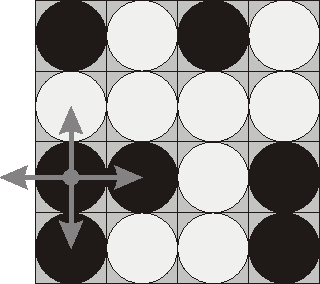题目描述
Description
Flip game is played on a rectangular 4x4 field with two-sided pieces placed on each of its 16 squares. One side of each piece is white and the other one is black and each piece is lying either it's black or white side up. Each round you flip 3 to 5 pieces,
thus changing the color of their upper side from black to white and vice versa. The pieces to be flipped are chosen every round according to the following rules:
 Consider the following position as an example:
Consider the following position as an example:
bwbw
wwww
bbwb
bwwb
Here "b" denotes pieces lying their black side up and "w" denotes pieces lying their white side up. If we choose to flip the 1st piece from the 3rd row (this choice is shown at the picture), then the field will become:
bwbw
bwww
wwwb
wwwb
The goal of the game is to flip either all pieces white side up or all pieces black side up. You are to write a program that will search for the minimum number of rounds needed to achieve this goal.
- Choose any one of the 16 pieces.
- Flip the chosen piece and also all adjacent pieces to the left, to the right, to the top, and to the bottom of the chosen piece (if there are any).
 Consider the following position as an example:
Consider the following position as an example: bwbw
wwww
bbwb
bwwb
Here "b" denotes pieces lying their black side up and "w" denotes pieces lying their white side up. If we choose to flip the 1st piece from the 3rd row (this choice is shown at the picture), then the field will become:
bwbw
bwww
wwwb
wwwb
The goal of the game is to flip either all pieces white side up or all pieces black side up. You are to write a program that will search for the minimum number of rounds needed to achieve this goal.
Input
The input consists of 4 lines with 4 characters "w" or "b" each that denote game field position.
Output
Write to the output file a single integer number - the minimum number of rounds needed to achieve the goal of the game from the given position. If the goal is initially achieved, then write 0. If it's impossible to achieve the goal, then write the word "Impossible"
(without quotes).
Sample Input
bwwb bbwb bwwb bwww
Sample Output
4
题目大意 有一个4x4的棋盘 每次翻转一个棋子 这个棋子四周的棋子也会发生翻转
问你的到纯黑 和纯白的棋子 最少 需要多少步
这里是4x4的棋盘 最多可以改变的棋子有16个
因此可枚举改变棋子的个数 从0到16
然后遍历每个棋子对应的位置 找到合格的就可以了
每个棋子只有两种状态 黑 和 白
用dfs 思路是把 改变的位置进行排列组合 这样就能看成树 树的深度是 改变的棋子数减一
因此可以用dfs优化
#include<iostream>
#include<cstdio>
#include<cstring>
using namespace std;
bool chess[6][6]={false};//利用的只有中心的4x4
bool flag;
int step;
int r[]={-1,1,0,0,0};//便于翻棋操作
int c[]={0,0,-1,1,0};
bool judge_all()//判断“清一色”
{
int i,j;
//这里和第一个比较 进行判断
for(i=1;i<5;i++)
for(j=1;j<5;j++)
if(chess[i][j]!=chess[1][1])
return false;
return true;
}
void flip(int row,int col)//翻棋
{
int i;
//这里用一个r数组和c数组 进行翻棋 时间优化 虽然节省的时间不多
for(i=0;i<5;i++)
chess[row+r[i]][col+c[i]]=!chess[row+r[i]][col+c[i]];
return;
}
void dfs(int row,int col,int deep) //深搜的迭代回溯是重点,很容易混乱
{
if(deep==step)
{
flag=judge_all();
return;
}
if(flag||row==5)return;
flip(row,col); //翻棋
if(col<4)
dfs(row,col+1,deep+1);
else
dfs(row+1,1,deep+1);
flip(row,col); //不符合则翻回来
//这里利用deep的数值进行dfs 从而将所有的地方都遍历到
if(col<4)
dfs(row,col+1,deep);
else
dfs(row+1,1,deep);
return;
}
int main()
{
char temp;
int i,j;
for(i=1;i<5;i++)
for(j=1;j<5;j++)
{
cin>>temp;
if(temp=='b')
chess[i][j]=true;
}
for(step=0;step<=16;step++) //对每一步产生的可能性进行枚举
{ //至于为什么是16,考虑到4x4=16格,而每一格只有黑白两种情况,则全部的可能性为2^16
dfs(1,1,0);
if(flag)break;
}
if(flag)
cout<<step<<endl;
else
cout<<"Impossible"<<endl;
return 0;
}







 本文介绍了一个4x4棋盘翻转游戏的算法解决方案,目标是在最少步骤内将所有棋子统一颜色。文章详细解释了游戏规则,并通过深度优先搜索(DFS)策略实现了最优解的求解。
本文介绍了一个4x4棋盘翻转游戏的算法解决方案,目标是在最少步骤内将所有棋子统一颜色。文章详细解释了游戏规则,并通过深度优先搜索(DFS)策略实现了最优解的求解。
















 2278
2278

 被折叠的 条评论
为什么被折叠?
被折叠的 条评论
为什么被折叠?








